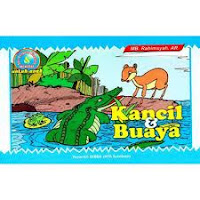One of the news from The Jakarta Post to day gave me inspiration to write an article. And I took the topic about “ Are Fables relevant to be told to our children in today ?”
My sons are student . The old one, his name’s Dixa, Fifth grade of Elementary in YPK, and the younger brother's name Majid, is student from Pre elementary (kindergarten) . When I told about tale fable to them. Definitely, one of them says “Is the animal same with people, can they speak, dad ?”.
Some day, the younger saw TV advert about Pepsodent ( Irgi Fahrezy and the kid ). He looked like a complaint, and then said “ Does the monkey can talk?, it’s non sense.”
In the past, when I studied in Elementary School, about 30 years ago. I think the tale fables, like “ Kancil dan Buaya”, " Kancil dan Pak Tani",“Si Udang bungkuk” are very popular to us. The els, stories of Cinderela. I think that stories are the same as the “Timun Emas”, right ?. Cinderella sneaks out in a wooden carriage at night to escape a bad home life, while kindhearted Snow White does the dirty work for a bunch of strangers, until a prince comes along to sweep her off her feet.
These are some of the most popular characters of fairy-tales, but are they still relevant in today’s changed world ?. How about Indonesian classic, tale of stories “ Bandung Bondowoso”,” Lutung Kasarung” and so on.
Children are always fascinated by stories, and if told properly, their facial expressions and gestures will follow the flow of a story, using their imagination and inviting different emotional expressions.
Children’s fascination in stories has encouraged parents, and even teachers, to tell or make up stories to teach them certain values in life.
There are good news, Even the Corruption Eradication Commission (KPK) published story books to teach nine important values crucial to form an anticorruption mentality in children.
The nine values are : Cooperation, Fairness, Responsibility, Care, Honesty, Discipline, Courage, Perseverance and Modesty — are taught through a fable for kindergarten students.
The KPK believed that the fable could serve as a better alternative to a popular folktale, titled Si Kancil Mencuri Ketimun (A Mouse-Deer Stealing Cucumbers), which it has long criticized for failing to deliver an anticorruption idea to children.
What do you think about it’s, are you agree ....???
Director of education and community service,Dedi A. Rachim says, “I think there is a little contradiction in the old story of the mouse deer. The mouse-deer stole [cucumbers], but at the end of the story, it is treated as a hero act,”.
Across the country, there are countless children stories but the Kancil stories are very popular. The most popular version tells of a hungry mouse-deer that repeatedly stole cucumbers in a farmer’s garden. Angry, the farmer put up a scarecrow smeared by strong glue to trap the mouse-deer and the trick worked well. The farmer, who intended to cook the mouse-deer, locked it in a cage and ordered his dog to guard it.
In a desperate attempt to save its life, the mouse-deer tricked the dog and freed itself.
In a way, Kancil has some bad sides, Sly (licik), annoying (menjengkelkan) ,but it’s also smart in looking for a solution to solve a problem. It depends on how we retell the story. Of course, We can take moral values from folklores, but they don’t directly make us moralists.
Now, what point will we take from a tale to your children ?
Action in storytelling might be interesting and amusing for children, but a clear plot was more important because it was the key to ensure children’s understanding.
In fact, stories could serve as effective teaching media as well as entertainment, where it is enjoyed and appreciated. Depend. …………………………………….( Majid’s father / inspired by “fairy tales”)
